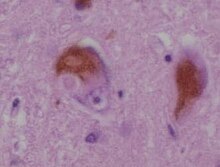Lewy body


Lewy bodies are abnormal aggregates of protein that develop inside nerve cells in Parkinson's disease (PD), Lewy body dementia, and some other disorders. They are identified under the microscope when histology is performed on the brain.
Lewy bodies appear as spherical masses that displace other cell components. The two morphological types are classical (brain stem) Lewy bodies and cortical Lewy bodies. A classical Lewy body is an eosinophilic cytoplasmic inclusion consisting of a dense core surrounded by a halo of 10-nm-wide radiating fibrils, the primary structural component of which is alpha-synuclein. Cortical Lewy bodies are also composed of alpha-synuclein fibrils, but are less defined and lack halos. In histopathology, Cortical Lewy bodies are a distinguishing feature for dementia with Lewy bodies (DLB), but may occasionally be seen in ballooned neurons characteristic of Pick's disease and corticobasal degeneration,[1] as well as in patients with other tauopathies.[2] They are also seen in cases of multiple system atrophy, particularly the Parkinsonian variant.[3]
History
Lewy bodies were discovered by Frederic Lewy in 1912.
Cell biology

A Lewy body is composed of the protein alpha-synuclein associated with other proteins, such as ubiquitin,[5] neurofilament protein, and alpha B crystallin. Tau proteins may also be present, and Lewy bodies may occasionally be surrounded by neurofibrillary tangles.[6][7] Lewy bodies and NFTs can occasionally exist in the same neuron, particularly in the amygdala.[8]
Lewy bodies are believed to represent an aggresome response in the cell.[9]
Lewy neurites
Lewy neurites are abnormal neurites in diseased neurons, containing granular material and abnormal α-synuclein filaments similar to those found in Lewy bodies.[10] Like Lewy bodies, lewy neurites are a feature of α-synucleinopathies such as dementia with Lewy bodies, Parkinson's disease, and multiple system atrophy.[11] They are also found in the CA2-3 region of the hippocampus in Alzheimer's disease.[11]
Cultural reference
Celebrities
Notable people who suffered from Lewy body dementia include:
- Actor Robin Williams
- Actress Estelle Getty
- Music industry icon Casey Kasem
- Athlete Stan Mikita
- Artist Don Featherstone, creator of the iconic lawn flamingo.
In fiction
- In the premiere episode of Boss, Dr. Ella Harris tells Chicago Mayor Tom Kane he has Lewy bodies, and his progressing symptoms are shown in each episode.
See also
References
- ^ Dickson DW, Feany MB, Yen SH, Mattiace LA, Davies P. (1996). "Cytoskeletal pathology in non-Alzheimer degenerative dementia: new lesions in diffuse Lewy body disease, Pick's disease, and corticobasal degeneration". Journal of Neural Transmission. Supplementum. 47: 31–46. doi:10.1007/978-3-7091-6892-9_2. PMID 8841955.
{{cite journal}}: CS1 maint: multiple names: authors list (link) - ^ Popescu, A; Lippa, CF; Lee, VM; Trojanowski, JQ (2004). "Lewy Bodies in the Amygdala: Increase of -Synuclein Aggregates in Neurodegenerative Diseases With Tau-Based Inclusions". Archives of Neurology. 61 (12): 1915–1919. doi:10.1001/archneur.61.12.1915. PMID 15596612.
- ^ Jellinger KA (2007). "More frequent Lewy bodies but less frequent Alzheimer-type lesions in multiple system atrophy as compared to age-matched control brains". Acta Neuropathologica. 114 (3): 299–303. doi:10.1007/s00401-007-0227-4. PMID 17476513.
- ^ Braak H, Del Tredici K, Rüb U, de Vos RA, Jansen Steur EN and Braak E (March–April 2003). "Staging of brain pathology related to sporadic Parkinson's disease". Neurobiol Aging. 24 (2): 197–211. doi:10.1016/S0197-4580(02)00065-9. PMID 12498954.
{{cite journal}}: CS1 maint: multiple names: authors list (link) CS1 maint: year (link) - ^ Engelender S (April 2008). "Ubiquitination of alpha-synuclein and autophagy in Parkinson's disease". Autophagy. 4 (3): 372–4. doi:10.4161/auto.5604. PMID 18216494.
- ^ Ishizawa, Takashi MD; Matilla, Petri MD, PhD; Davies, Peter PhD; Wang, Dengshun MD; Dickson, Dennis W. MD (April 2003). [Colocalization of Tau and Alpha-Synuclein Epitopes in Lewy Bodies "Colocalization of tau and alpha-synuclein epitopes in Lewy bodies"]. Journal of Neuropathology & Experimental Neurology. 62 (4): 389–397. PMID 12722831.
{{cite journal}}: Check|url=value (help)CS1 maint: multiple names: authors list (link) - ^ Arima, K; Hirai, S; Sunohara, N; Aoto, K; Izumiyama, Y; Uéda, K; Ikeda, K; Kawai, M; Arima K, Hirai S, Sunohara N, Aoto K, Izumiyama Y, Uéda K, Ikeda K, Kawai M. (1999). "Cellular co-localization of phosphorylated tau- and NACP/alpha-synuclein-epitopes in Lewy bodies in sporadic Parkinson's disease and in dementia with Lewy bodies". Brain Research. 843 (1–2): 53–61. doi:10.1016/S0006-8993(99)01848-X. PMID 10528110.
{{cite journal}}: CS1 maint: multiple names: authors list (link) - ^ Marie Luise Schmidt, John A. Martin, Virginia M.-Y. Lee, John Q. Trojanowski (1996). "Convergence of Lewy bodies and neurofibrillary tangles in amygdala neurons of Alzheimer's disease and Lewy body disorders". Acta Neuropathol. 91 (5): 475–81. doi:10.1007/s004010050454. PMID 8740227.
{{cite journal}}: CS1 maint: multiple names: authors list (link) - ^ Tanaka M, Kim YM, Lee G, Junn E, Iwatsubo T, Mouradian MM (February 2004). "Aggresomes formed by alpha-synuclein and synphilin-1 are cytoprotective". J. Biol. Chem. 279 (6): 4625–31. doi:10.1074/jbc.M310994200. PMID 14627698.
{{cite journal}}: CS1 maint: multiple names: authors list (link) CS1 maint: unflagged free DOI (link) - ^ Maria Grazia Spillantini, R. Anthony Crowther, Ross Jakes, Masato Hasegawa, Michel Goedert (26 May 1998). "α-Synuclein in filamentous inclusions of Lewy bodies from Parkinson's disease and dementia with Lewy bodies". PNAS. 95 (11): 6469–73. doi:10.1073/pnas.95.11.6469. PMC 27806. PMID 9600990.
{{cite journal}}: CS1 maint: multiple names: authors list (link) - ^ a b Wami Marui, Eizo Iskei, Masanori Kato, Hiroyasu Akatsu, Kenji Kosaka (2004). "Pathological entity of dementia with Lewy bodies and its differentiation from Alzheimer's disease". Acta Neuropathologica. 108 (2): 121–8. doi:10.1007/s00401-004-0869-4. PMID 15235805.
{{cite journal}}: CS1 maint: multiple names: authors list (link)
